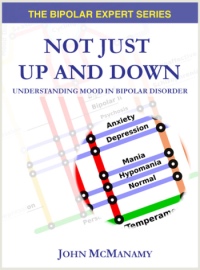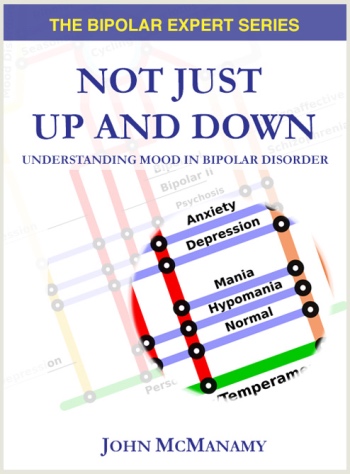Multipolar Depression
 |
Where Unipolar Meets Bipolar.
|
All is not as it appears to be. On one hand, there is a strong case to be made that unipolar depression and bipolar disorder have much in common, so much so that they should be regarded as sharing an overlapping illness spectrum that includes anxiety and psychosis. On the other, the very dissimilar ways unipolar and bipolar depression tend to manifest and are treated suggest two and possibly many more entirely different biological animals.
Why Unipolar Depression and Bipolar Depression are Different
At the 2001 Fourth International Conference on Bipolar Disorder, Guy Goodwin MD, head of the Department of Psychiatry at Oxford, let drop: "There is a difference between unipolar and bipolar depression." The DSM-IV does not see it that way, however, with the symptoms from unipolar depression literally copied and pasted with no comment into the section for the depressed phase of bipolar disorder. The DSM-5, due out in 2013, will continue to take the lazy way out.
My New Book!

Purchase now.
Clinical reality and research, however, paint a far different picture (see Bipolar Depression article). At the same conference, a poster by Hagop Akiskal of the University of California at San Diego and others pointed out some of the distinguishing characteristics based on a comparison of 493 subjects with either unipolar or bipolar II depression. For one, there was overrepresentation in the BP II group of "suicidal thoughts, guilt feelings, depersonalization and derealization, and atypical features such as hypersomnia and weight gain." The unipolar group experienced higher psychic anxiety and initial insomnia, and assessed themselves significantly higher in terms of slow thinking, feeling the worst, avoiding risks, life dull and dreary, dragging from day to day, and feeling to have no energy.
A study from the same conference by LC Schaffner and DF MacKinnon, both of Johns Hopkins, also found bipolar individuals were more likely than those with unipolar depression to display psychotic features during a depressive episode (30 percent vs six percent). Those with bipolar I had more ECTs (18 percent vs six percent) suggesting more severe depressions, and more suicidal episodes (33 percent vs eight percent).
A unipolar patient's lifesaver may often be a bipolar patient's life threat. Though some bipolar patients may benefit on an antidepressant, the evidence indicates that most do not . Bipolar patients have a strong tendency to fly into mania or extreme agitation on an antidepressant, so much so that the American Psychiatric Association in its 2002 Bipolar Treatment Guidelines expressly rules out treating a bipolar patient with an antidepressant unless that patient is also taking a mood stabilizing medication. Instead, bipolar patients experiencing depression tend to get treated with Lamictal (which does not appear to work for unipolar depression), lithium (which is also used to augment an antidepressant for unipolar depression), and certain antipsychotics (such as Seoquel).
Just to show you how truly difficult life is, antidepressants can be dangerous for certain types of unipolar depression, as well. At the same conference, Athanasios Koukopoulos MD of the University of Rome noted that agitated depression has been relegated to a symptom of depression in the DSM-IV ("psychomotor agitation or retardation"), meaning "major depressive episodes with or without agitation are treated in the same way, and the result is disastrous in many cases of agitated depression." Then there are psychotic depressions, excited and anxious depressions, and dysphoric moods, many induced by antidepressants, not to mention many who rapid-cycle after being prescribed an antidepressant. Toss in the various bipolar mixed states, and it is a virtual certainty that the editors of the next DSM will not meet their deadlines.
The first thing to diagnose, says Dr Koukopoulos, is the patient's temperament. If the patient is agitated, the first course of treatment is "anything that calms him down." Sometimes, the depression stops along with the agitation. Other times, what follows is pure simple depression, which can be treated with antidepressants. "It is better," he says, "that things go slowly than trying to get well all at once."
Where Unipolar Depression and Bipolar Depression Converge
With these difficult to treat depressions the circle closes, as we begin to see traits that have something in common with bipolar disorder, not enough to suggest a bipolar diagnosis, perhaps, at least not right now. Should a future DSM (say the DSM-75, due out in 2343), however, adopt softer criteria, we may well see bipolar disorder broken down not only into I and II - as it has been since the 1994 - but also bipolar III, IV, and maybe even V. Here, truly we are talking about a multipolar phenomenon.
Dr Akiskal has been the main proponent of an expanded definition of bipolar disorder, one that would incorporate a good deal of the current unipolar population. Dr Akiskal has pointed out that many patients with so-called unipolar depression exhibit certain hypomanic (mild mania) symptoms. Though these symptoms may not add up to an actual hypomanic episode, Dr Akiskal maintains they constitute sufficient evidence of bipolarity, and thus has urged that this population be diagnosed accordingly.
In an article in the July 2004 AJP, Ellen Frank PhD of the University of Pittsburgh et al take the argument one step farther by proposing there is a strong relationship between hypomanic or manic symptoms and the number and severity of depressive episodes.
To test this proposition, 117 adult patients with recurrent unipolar depression with no history of hypomanic episodes, and 106 patients with bipolar I were drawn from a larger Italian study group and administered a 140-item interview. Predictably the bipolar I patients had a lot more lifetime manic/hypomanic symptoms than the unipolar group. Nevertheless, there were 12 items associated with hypomania (from high mood to irritability) that were each present in at least 40 percent of the depressed patients. Patients with a higher number of lifetime manic/hypomanic symptoms had a higher number of lifetime depressed symptoms (and vice-versa), a finding that held for both the bipolar and unipolar patients.
Then the investigators zeroed in on indicators of paranoid and suicidal ideation. What they found was that in the group with unipolar depression, each manic/hypomanic item increased the likelihood of suicidal ideation by 4.2 percent. For 10 items, this would equate to a 42 percent increased risk. Also, earlier first onset depression correlated with a higher number of manic/hypomanic symptoms. In bipolar I patients the number of manic/hypomanic items was also related to paranoid and suicidal ideation, but not to number of lifetime episodes.
The authors contend that their findings "support a continuous view of the mood spectrum as a unitary phenomenon" and that clinical attention needs to be paid to manic/hypomanic manifestations that occur in recurrent unipolar depression.
Conclusion
Some of you may be DSM-IV classic depression cases waiting to become DSM-V or DSM-VI novelties, either by staying within the unipolar depression family as part of a new species or crossing over into bipolar disorder camp as one of a new breed. The DSM-V is scheduled for 2011, but you need not have to wait that long for psychiatry to catch up to your personal reality. A competent psychiatrist over the course of a careful examination (not a 10-minutes meds check) should be able to tease out symptoms that may distinguish you from his or her garden variety patients, and work with you accordingly. In some cases this may involve treating you as if you were a bipolar patient - using antidepressants with extra caution, if at all, and going with mood stabilizers.
But even the best psychiatrist in the world is only as good as what you tell him or her. So as well confiding to your psychiatrist about how miserable you are, come prepared to talk about those times you felt agitated and irritable and even a little hyper. In other words, give your psychiatrist something to work with. We're still learning as we go, but even a marginal improvement in outcome can make all the difference in the world, here.
See also: Hard Depression, Soft Bipolar and The Mood Spectrum
April 8, 2005, reviewed Jan 3, 2010
 |
More articles on mood. |




